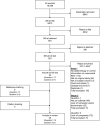Risk of nosocomial respiratory syncytial virus infection and effectiveness of control measures to prevent transmission events: a systematic review
- PMID: 26901358
- PMCID: PMC4910170
- DOI: 10.1111/irv.12379
Risk of nosocomial respiratory syncytial virus infection and effectiveness of control measures to prevent transmission events: a systematic review
Abstract
Respiratory syncytial virus (RSV) causes a significant public health burden, and outbreaks among vulnerable patients in hospital settings are of particular concern. We reviewed published and unpublished literature from hospital settings to assess: (i) nosocomial RSV transmission risk (attack rate) during outbreaks, (ii) effectiveness of infection control measures. We searched the following databases: MEDLINE, EMBASE, CINAHL, Cochrane Library, together with key websites, journals and grey literature, to end of 2012. Risk of bias was assessed using the Cochrane risk of bias tool or Newcastle-Ottawa scale. A narrative synthesis was conducted. Forty studies were included (19 addressing research question one, 21 addressing question two). RSV transmission risk varied by hospital setting; 6-56% (median: 28·5%) in neonatal/paediatric settings (n = 14), 6-12% (median: 7%) in adult haematology and transplant units (n = 3), and 30-32% in other adult settings (n = 2). For question two, most studies (n = 13) employed multi-component interventions (e.g. cohort nursing, personal protective equipment (PPE), isolation), and these were largely reported to be effective in reducing nosocomial transmission. Four studies examined staff PPE; eye protection appeared more effective than gowns and masks. One study reported on RSV prophylaxis for patients (RSV-Ig/palivizumab); there was no statistical evidence of effectiveness although the sample size was small. Overall, risk of bias for included studies tended to be high. We conclude that RSV transmission risk varies widely during hospital outbreaks. Although multi-component control strategies appear broadly successful, further research is required to disaggregate the effectiveness of individual components including the potential role of palivizumab prophylaxis.
Keywords: Infection control; nosocomial infections; palivizumab; personal protective equipment; respiratory syncytial virus.
© 2016 The Authors. Influenza and Other Respiratory Viruses Published by John Wiley & Sons Ltd.
Figures

References
-
- Hall CB. Respiratory syncytial virus and parainfluenza virus. New Engl J Med 2001; 344:1917–1928. - PubMed
-
- Falsey AR, Hennessey PA, Formica MA et al Respiratory syncytial virus infection in elderly and high‐risk adults. New Engl J Med 2005; 352:1749–1759. - PubMed
-
- Murata Y, Falsey AR. Respiratory syncytial virus infection in adults. Antivir Ther 2007;12:659–670. - PubMed
Publication types
MeSH terms
Grants and funding
LinkOut - more resources
Full Text Sources
Other Literature Sources
Medical

